Koji Suzuki.pdf
Koji Suzuki.pdf
Koji Suzuki.pdf
You also want an ePaper? Increase the reach of your titles
YUMPU automatically turns print PDFs into web optimized ePapers that Google loves.
<strong>Koji</strong> <strong>Suzuki</strong> et al<br />
to modify adipocyte glucose and lipid metabolism and<br />
impact on body weight (Berg et al., 1994; Greenberg et al.,<br />
1992), and administration of human recombinant IL-6 to<br />
humans has been shown to induce hyperglycemia and<br />
compensatory hyperinsulinemia (Tsigos et al., 1997).<br />
Hyperglycemia increases the generation of free radicals by<br />
glucose autoxidation and Maillard’s reaction (Sakurai and<br />
Tsuchiya, 1988; Gilley et al., 1988). Accordingly, serum<br />
levels of carotenoids such as β-carotene might be depleted<br />
in obese subjects.<br />
Carotenoids, such as β-carotene, protect cells from<br />
oxidative stress by quenching free radicals (Bendich and<br />
Olson, 1989). Smoking is known to generate ROS in vivo,<br />
and it has been reported that serum levels of carotenoids<br />
like β-carotene and β-cryptoxanthin are lower in smokers<br />
than in non-smokers (Aoki et al., 1987; Ito et al., 1991). In<br />
our present study, 36.7% of males were current smokers, a<br />
rate 5 times greater than that for females. Since so many<br />
men were smokers and smoking has a strong effect on serum<br />
carotenoid levels, this might be explain the lack of any<br />
significant relationship between obesity and serum<br />
carotenoid levels in men in our study. After adjusting for<br />
confounding factors, however, the odds ratios for high serum<br />
carotenoid levels were significantly lower in the obese<br />
compared to the non-obese group in both genders.<br />
No significant differences in serum levels of oxLDL and<br />
oLAB were observed between non-obese and obese groups<br />
in either gender, although the adjusted odds ratio for high<br />
serum oxLDL levels was significantly elevated in the<br />
hypertensive individuals and that for high serum oLAB<br />
levels tended to be higher in obese subjects who were<br />
hypertension. A limitation of this study was that the sample<br />
sizes for serum oxLDL and oLAB were relatively small. It<br />
has been reported that serum levels of oxLDL and oLAB<br />
are higher in patients with CHD, and may be risk factors<br />
(Parums et al., 1990). OxLDL is generated by the action of<br />
ROS and is believed to play a critical role in the development<br />
and progression of atherosclerosis (Witztum and Steinberg,<br />
1991). It is taken up by macrophages and oLAB is present<br />
both in atherosclerotic lesions and plasma (Witztum, 1994),<br />
where it may control the increase of oxLDL. Actually, serum<br />
oLAB levels are reported to be negatively correlated with<br />
plasma oxLDL levels in healthy subjects (Shoji et al., 2000)<br />
In this study, the odds ratio for elevated serum oLAB levels<br />
tended to be higher in obese subjects with hypertension.<br />
Therefore, it is thought that serum oxLDL and oLAB levels<br />
may be considered as biomarkers for high blood pressure.<br />
Leptin is a hormone that is secreted from adipocytes and is<br />
involved in satiety regulation (Zhang et al., 1994; Sarraf et<br />
al., 1997). It is well known that serum leptin levels are<br />
significantly higher in obese compared with non-obese<br />
subjects (Considine et al., 1996), a finding which our study<br />
confirmed. Leptin production and secretion are mainly<br />
determined by the size of adipose tissue depot.<br />
However, numerous hormones, cytokines, and cytokinelike<br />
proteins may also exert an influence (Kristensen et al.,<br />
1999; Trayhurn et al., 1999) and TNF-α administration is<br />
264<br />
Asian Pacific Journal of Cancer Prevention, Vol 4, 2003<br />
known to increased plasma leptin levels in mice (Sarraf et<br />
al., 1997; Berkowitz et al., 1998). Circulating leptin levels<br />
may also rise with inflammation (Bornstein et al., 1998). In<br />
our study, serum leptin levels were significantly and<br />
positively associated with serum CRP levels in both genders<br />
after adjustment for confounding factors.<br />
In conclusion, obesity has found to be highly associated<br />
with states of oxidative stress and low-grade inflammation<br />
in Japanese subjects. We suggest that these processes may<br />
play an important role in the relation between obesity and<br />
certain cancers as well as CHD.<br />
Acknowledgments<br />
The authors express their sincere appreciation to Dr.<br />
Kunio Aoki, Professor Emeritus, Nagoya University School<br />
of Medicine and the former chairman of the JACC Study<br />
Group, and also to Dr. Haruo Sugano, the former Director<br />
of the Cancer Institute of the Japanese Foundation for Cancer<br />
Research, who greatly contributed to the initiation of the<br />
study.<br />
The present members of the JACC Study and their<br />
affiliations are as follows: Dr. Akiko Tamakoshi (present<br />
chairman of the study group), Nagoya University Graduate<br />
School of Medicine; Dr. Mitsuru Mori, Sapporo Medical<br />
University School of Medicine; Dr. Yutaka Motohashi, Akita<br />
University School of Medicine; Dr. Ichiro Tsuji, Tohoku<br />
University Graduate School of Medicine; Dr. Yosikazu<br />
Nakamura, Jichi Medical School; Dr. Hiroyasu Iso, Institute<br />
of Community Medicine, University of Tsukuba; Dr. Haruo<br />
Mikami, Chiba Cancer Center; Dr. Yutaka Inaba, Juntendo<br />
University School of Medicine; Dr. Yoshiharu Hoshiyama,<br />
Showa University School of Medicine; Dr. Hiroshi <strong>Suzuki</strong>,<br />
Niigata University Graduate School of Medical and Dental<br />
Sciences; Dr. Hiroyuki Shimizu, Gifu University School of<br />
Medicine; Dr. Hideaki Toyoshima, Nagoya University<br />
Graduate School of Medicine; Dr. Shinkan Tokudome,<br />
Nagoya City University Graduate School of Medicine; Dr.<br />
Yoshinori Ito, Fujita Health University School of Health<br />
Sciences; Dr. Shuji Hashimoto, Fujita Health University<br />
School of Medicine; Dr. Shogo Kikuchi, Aichi Medical<br />
University School of Medicine; Dr. Akio Koizumi, Graduate<br />
School of Medicine and Faculty of Medicine, Kyoto<br />
University; Dr. Takashi Kawamura, Kyoto University Center<br />
for Student Health; Dr. Yoshiyuki Watanabe and Dr.<br />
Tsuneharu Miki, Kyoto Prefectural University of Medicine<br />
Graduate School of Medical Science; Dr. Chigusa Date,<br />
Faculty of Human Environmental Sciences, Mukogawa<br />
Women’s University ; Dr. Kiyomi Sakata, Wakayama<br />
Medical University; Dr. Takayuki Nose, Tottori University<br />
Faculty of Medicine; Dr. Norihiko Hayakawa, Research<br />
Institute for Radiation Biology and Medicine, Hiroshima<br />
University; Dr. Takesumi Yoshimura, Institute of Industrial<br />
Ecological Sciences, University of Occupational and<br />
Environmental Health, Japan; Dr. Katsuhiro Fukuda,<br />
Kurume University School of Medicine; Dr. Naoyuki<br />
Okamoto, Kanagawa Cancer Center; Dr. Hideo Shio,










